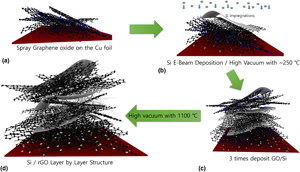Article contents
Highly stable multi-layered silicon-intercalated graphene anodes for lithium-ion batteries
Published online by Cambridge University Press: 26 February 2020
Abstract

To avoid degradation of silicon anodes in lithium-ion batteries (LIBs), the authors report a new two-dimensional multi-layered Si-intercalated rGO (rGO/Si) anode prepared by direct growth of Si into a porous multi-layered reduced graphene oxide (rGO) film. Direct Si deposition onto the porous rGO film allows the Si layers to be intercalated into the film via in situ replacement of the oxygen groups of the multi-layered graphene oxide (GO) with Si through thermal reduction of the GO film. The porous rGO acts as a cushion against the expansion of the Si layer during lithiation, preventing the Si from being pulverized and producing highly stable LIBs.
Information
- Type
- Research Letters
- Information
- Copyright
- Copyright © Materials Research Society 2020
References
1.Chae, C., Noh, H.-J., Lee, J.K., Scrosati, B., and Sun, Y.-K.: A high-energy Li-ion battery using a silicon-based anode and a nano-structured layered composite cathode. Adv. Funct. Mater. 24, 3036 (2014).CrossRefGoogle Scholar
2.Westover, A.S., Freudiger, D., Gani, Z.S., Share, K., Oakes, L., Carter, R.E., and Pint, C.L.: On-chip high power porous silicon lithium ion batteries with stable capacity over 10,000 cycles. Nanoscale 7, 98 (2015).CrossRefGoogle ScholarPubMed
3.Kasavajjula, U., Wang, C., and Appleby, A.J.: Nano- and bulk-silicon-based insertion anodes for lithium-ion secondary cells. J. Power Sources 163, 1003 (2007).CrossRefGoogle Scholar
4.Lu, Z., Liu, N., Lee, H.-W., Zhao, J., Li, W., Li, Y., and Cui, Y.: Nonfilling carbon coating of porous silicon micrometer-sized particles for high-performance lithium battery anodes. ACS Nano 9, 2540 (2015).CrossRefGoogle ScholarPubMed
5.Zhou, X., Yin, Y.-X., Wan, L.-J., and Guo, Y.-G.: Self-assembled nanocomposite of silicon nanoparticles encapsulated in graphene through electrostatic attraction for lithium-ion batteries. Adv. Energy Mater. 2, 1086 (2012).CrossRefGoogle Scholar
6.Chan, C.K., Peng, H., Liu, G., McIlwrath, K., Zhang, X.F., Huggins, R.A., and Cui, Y.: High-performance lithium battery anodes using silicon nanowires. Nat. Nanotechnol. 3, 31 (2008).CrossRefGoogle ScholarPubMed
7.Zhou, X., Yin, Y.X., Wan, L.J., and Guo, Y.G.: Facile synthesis of silicon nanoparticles inserted into graphene sheets as improved anode materials for lithium-ion batteries. Chem. Commun. (Cambridge) 48, 2198 (2012).CrossRefGoogle ScholarPubMed
8.Li, Q., Yin, L., and Gao, X.: Reduction chemical reaction synthesized scalable 3D porous silicon/carbon hybrid architectures as anode materials for lithium ion batteries with enhanced electrochemical performance. RSC Adv. 5, 35598 (2015).CrossRefGoogle Scholar
9.Li, X., Gu, M., Hu, S., Kennard, R., Yan, P., Chen, X., Wang, C., Sailor, M.J., Zhang, J.G., and Liu, J.: Mesoporous silicon sponge as an anti-pulverization structure for high-performance lithium-ion battery anodes. Nat. Commun. 5, 4105 (2014).CrossRefGoogle ScholarPubMed
10.Lin, H., Weng, W., Ren, J., Qiu, L., Zhang, Z., Chen, P., Chen, X., Deng, J., Wang, Y., and Peng, H.: Twisted aligned carbon nanotube/silicon composite fiber anode for flexible wire-shaped lithium-ion battery. Adv. Mater. 26, 1217 (2014).CrossRefGoogle ScholarPubMed
11.Lee, J.K., Smith, K.B., Hayner, C.M., and Kung, H.H.: Silicon nanoparticles-graphene paper composites for Li ion battery anodes. Chem. Commun. (Cambridge) 46, 2025 (2010).CrossRefGoogle ScholarPubMed
12.Chang, J., Huang, X., Zhou, G., Cui, S., Hallac, P.B., Jiang, J., Hurley, P.T., and Chen, J.: Multilayered Si nanoparticle/reduced graphene oxide hybrid as a high-performance lithium-ion battery anode. Adv. Mater. 26, 758 (2014).CrossRefGoogle ScholarPubMed
13.Wang, B., Li, X., Zhang, X., Luo, B., Jin, M., Liang, M., Dayeh, S.A., Picraux, S., and Zhi, L.: Adaptable silicon–carbon nanocables sandwiched between reduced graphene oxide sheets as lithium ion battery anodes. ACS Nano 7, 1437 (2013).CrossRefGoogle ScholarPubMed
14.Suresh, S., Wu, Z.P., Bartolucci, S.F., Basu, S., Mukherjee, R., Gupta, T., Hundekar, P., Shi, Y., Lu, T.M., and Koratkar, N.: Protecting silicon film anodes in lithium-Ion batteries using an atomically thin graphene drape. ACS Nano 11, 5051 (2017).CrossRefGoogle ScholarPubMed
15.Xu, C., Lindgren, F., Philippe, B., Gorgoi, M., Björefors, F., Edström, K., and Gustafsson, T.: Improved performance of the silicon anode for Li-ion batteries: understanding the surface modification mechanism of fluoroethylene carbonate as an effective electrolyte additive. Chem. Mater. 27, 2591 (2015).CrossRefGoogle Scholar
16.Bates, J., Dudney, N., Neudecker, B., Ueda, A., and Evans, C.: Thin-film lithium and lithium-ion batteries. Solid State Ion. 135, 33 (2000).CrossRefGoogle Scholar
17.Emtsev, K.V., Bostwick, A., Horn, K., Jobst, J., Kellogg, G.L., Ley, L., McChesney, J.L., Ohta, T., Reshanov, S.A., and Röhrl, J.: Towards wafer-size graphene layers by atmospheric pressure graphitization of silicon carbide. Nat. Mater. 8, 203 (2009).CrossRefGoogle ScholarPubMed
18.Tang, H., Tu, J.-p, Liu, X.-y., Zhang, Y.-j., Huang, S., Li, W.-z, Wang, X.-l., and Gu, C.-d: Self-assembly of Si/honeycomb reduced graphene oxide composite film as a binder-free and flexible anode for Li-ion batteries. J. Mater. Chem. A 2, 5834 (2014).CrossRefGoogle Scholar
19.Fairfield, J.M. and Masters, B.J.: Self-diffusion in intrinsic and extrinsic silicon. J. Appl. Phys. 38, 3148 (1967).CrossRefGoogle Scholar
- 5
- Cited by


